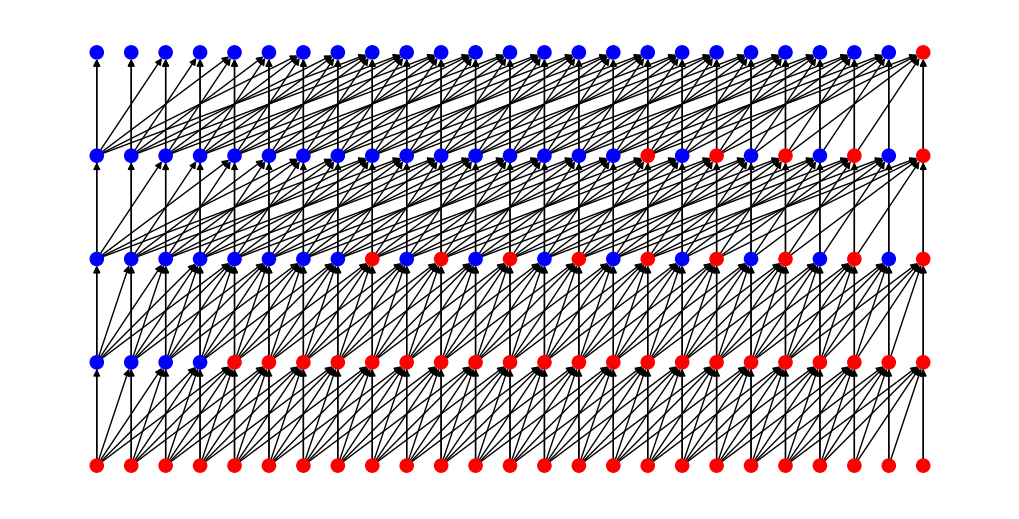This is a library for Temporal Convolutional Networks (TCNs) in PyTorch. It is based on the TCN as described in the paper An Empirical Evaluation of Generic Convolutional and Recurrent Networks for Sequence Modeling by Shaojie Bai, J. Zico Kolter and Vladlen Koltun. The code is largely based on the original PyTorch implementation from the authors.
Compared to the original code base, the following extra features were added:
- Support for batch normalization or/and weight normalization
- Possible to disable residual connections
- Support for ResNeXt blocks
- Support for depthwise separable convolutions
- Removed all possible double biases for optimal training speed (i.e. when using batch normalization)
- Performing Kaiming initialization for ReLU-activated networks
- Initializing batch norm weights to 1.0 and biases to 0.0
- Optionally zero-initially the last batch norm in each block (per https://arxiv.org/abs/1706.02677)
- Small
stats.pymodule to compute TCN properties such its receptive field size
pip install git+https://github.com/V0XNIHILI/TCN-library.git
# Or:
git clone git@github.com:V0XNIHILI/TCN-library.git
cd TCN-library
pip install -e .from tcn_lib import TCN
# Model without linear layer (for regression tasks), by setting output_size to -1
seq_mnist_tcn = TCN(1, -1, [25] * 8, 7)
# Model for sequential MNIST task
seq_mnist_tcn = TCN(1, 10, [25] * 8, 7)
# First 4 layers have kernel size 5, the next 4 layers have kernel size 7
seq_mnist_tcn = TCN(1, -1, [25] * 8, [5] * 4 + [7] * 4)
# Same model, but with batch normalization
seq_mnist_tcn_bn = TCN(1, 10, [25] * 8, 7, batch_norm=True)
# Now also include zero-initializing the last batch norm in each block
seq_mnist_tcn_bn_zi = TCN(1, 10, [25] * 8, 7, batch_norm=True, zero_init_residual=True)
# Same model, but with weight normalization
seq_mnist_tcn_wn = TCN(1, 10, [25] * 8, 7, weight_norm=True)
# Same model, but without residual connections
seq_mnist_tcn_no_res = TCN(1, 10, [25] * 8, 7, residual=False)
# Same model, but with 1x1 convolutions in all residual connections
seq_mnist_tcn_1x1 = TCN(1, 10, [25] * 8, 7, force_downsample=True)
# MNIST classification model with bottleneck blocks
seq_mnist_tcn_bottle = TCN(1, 10, [(64, 256)] * 8, 7, bottleneck=True)
# Same model, but with ResNeXt blocks
mnist_tcn_resnext = TCN(1, 10, [(64, 256)] * 8, 7, bottleneck=True, groups=32)
# Same model but with depthwise separable convolutions
mnist_tcn_depthwise = TCN(1, 10, [(64, 256)] * 8, 7, bottleneck=True, groups=-1)
# Same model, but with dropout
seq_mnist_tcn_dropout = TCN(1, 10, [25] * 8, 7, dropout=0.1)Various small functions to calculate properties such as the receptive field size of a TCN. For a variety of plots based on the properties of a TCN, please refer to this repository.
Get the receptive field size of a TCN kernel size 3 and with 4 layers:
from tcn_lib.stats import get_receptive_field_size
receptive_field = get_receptive_field_size(3, 4) # 61Get the closest (kernel size, number of layers) pair for a required receptive field size of 100:
from tcn_lib.stats import get_kernel_size_and_layers
kernel_size, num_layers = get_kernel_size_and_layers(100) # (9, 3)Plot a graph of a TCN with kernel size 5 and 2 layers:
import matplotlib.pyplot as plt
import networkx as nx
from tcn_lib.stats import get_kernel_size_and_layers, create_graph
G, pos, color_map = create_graph(5, 2) # Requires networkx pip package installed
plt.figure(figsize=(10, 5))
nx.draw(G, pos, with_labels=False, font_size=7, node_color=color_map, node_size=90)
plt.show()This project is licensed under the MIT License - see the LICENSE file for details.

